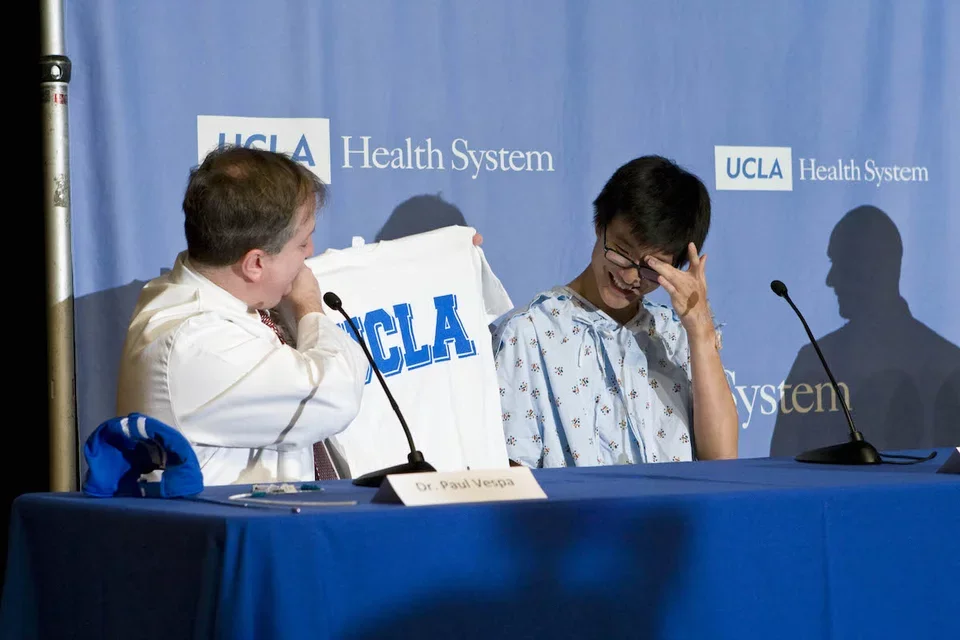Types of Traumatic Brain Injury
Research Spotlight

Meet Dr. Paul Vespa
Neurointensive care specialist Paul M. Vespa, MD treats patients for strokes and neurosurgical conditions, including traumatic brain injury (TBI). His work fulfills a driving purpose he identified early in life.
“Ever since I can remember, I was interested in helping people,” he says. “I wanted that to be a fundamental part of my life. Trying to serve a higher purpose and help our fellow humans is really what drives me to this day.”
A constantly curious child, he always wanted to figure out how things worked. His inquiries grew more complex over the years, focused on things he couldn’t simply take apart and figure out. He became especially interested in the brain. What mechanisms enabled it to regulate human behavior?
Dr. Vespa’s interests ultimately led him to neurointensive care—a neurology subspecialty that allowed him to explore brain function and fulfill his desire to have a lasting impact on patients.

Understanding Traumatic Brain Injury
What is TBI?
TBI stands for traumatic brain injury. It results from a blow to the head and impacts brain function.
What are the different types of traumatic brain injury?
Dr. Vespa says TBI can be defined and categorized in many different ways.
TBI classified by severity:
TBI classified by brain penetration:
TBI classified by symptom progression:
TBI differentiated by symptom presentation:
Mild TBI
What causes mild TBI?
Mild TBI most often results from an external blow to the head that leaves someone briefly dazed and may or may not result in a loss of consciousness. People often use “mild TBI” and “concussion” interchangeably.
What are the symptoms of mild TBI?
The most common symptoms of mild TBI include, but are not limited to:
- Headache
- Confusion
- Decreased short term memory
- Impaired thinking
- Impaired daily function
- Depression
Athletes with mild TBI may experience dizziness and activity-related headaches, in addition to the common symptoms above.
How is mild TBI diagnosed?
A TBI diagnosis begins with an initial evaluation of basic neurological function. Imaging scans may be needed to determine the injury’s severity. See all the steps involved in TBI diagnosis.
How is mild TBI treated?
Mild TBI treatment targets every patient’s specific symptoms. Learn more about TBI treatment.

Moderate to Severe TBI
What causes moderate to severe TBI?
Moderate to severe TBI can result from either a penetrating or a non-penetrating blow to the head.
What are the symptoms of moderate to severe TBI?
The most common symptoms of moderate to severe TBI include, but are not limited to:
- Loss of consciousness
- Prolonged loss of consciousness
- Seizures
- Weakness on one side or both sides of the body
- Vision changes
- Structural brain damage
- Bleeding in the brain
Dr. Vespa says patients with moderate to severe TBI sometimes exhibit emotional symptoms.
“Following an incident, a person may initially behave normally and then become combative, agitated, or delirious,” he says. “People may assume the person is simply upset about the incident, but those emotional reactions are actually symptoms of TBI.”
How is moderate to severe TBI diagnosed?
A TBI diagnosis begins with an initial evaluation of basic neurological function. Imaging scans may be needed to determine the injury’s severity. See all the steps involved in TBI diagnosis.
How is moderate to severe TBI treated?
Moderate to severe TBI may be treated through surgery, medication, or a number of other strategies. Learn more about TBI treatment.
Non-Penetrating TBI
In non-penetrating TBI, also called closed-head injuries, nothing has penetrated the brain. However, the external blow to the head may have caused structural damage to the skull and within the brain, such as:
- Bleeding in the brain
- Bleeding over the surface of the brain
- Bleeding in the brain’s ventricles (intraventricular bleeding)
“Bleeding inside the brain usually indicates a more moderate to severe injury,” Dr. Vespa says. “But you can have a severe case that includes no bleeding inside the brain.”
Penetrating TBI
Penetrating TBI results from any object striking the head, fracturing the skull, and penetrating into the brain. Most penetrating TBIs will be considered moderate to severe. Gunshot wounds make up a majority of penetrating TBI cases.
Primary TBI
Primary TBI refers to structural damage inside the brain, such as a bruise or a hemorrhage, that results directly from the initial blow to the head.
Secondary TBI
Secondary TBI refers to complications that develop after the initial blow to the head and cause additional damage to a brain already compromised by a primary injury.
Secondary TBI complications include:
- Pressure inside the brain
- Progressive brain swelling
- Artery damage, which may trigger stroke or seizure
- Lack of oxygen, related to a blood pressure crash or a period of arrested breathing
Concussive Brain Injury / Concussion
A concussion or concussive brain injury results from a blow to the head that leaves someone dazed and may or may not result in a loss of consciousness.
Concussions cause symptoms, which differentiates them from subconcussive brain injuries.
Subconcussive Brain Injury
A subconcussive brain injury results from a blow to the head that produces no noticeable symptoms. Patients with subconcussive injuries may not realize they’ve been injured.
Subconcussive injuries, while asymptomatic, can still cause complications, especially in patients who experience repetitive subconcussive injuries, such as athletes.
Dr. Vespa says a classic example is a soccer player frequently hitting the ball with their head.
Chronic traumatic encephalopathy (CTE)
Repeated brain injuries may lead to chronic traumatic encephalopathy (CTE), a rare degenerative brain condition. CTE cases are often associated with high-contact sports, including soccer, boxing, and football.
Dr. Vespa says CTE remains relatively mysterious in the field.
“It’s not yet clear exactly what causes CTE,” he explains. “The current accepted theory is that CTE is related to repetitive injuries over a long time, but there is some debate on that.”

TBI Diagnosis
A TBI diagnosis begins with an initial evaluation of basic neurological function, conducted in the emergency room or by first responders.
If the initial evaluation suggests altered neurological function, then physicians will order imaging scans, such as a magnetic resonance imaging (MRI) scan or a computed tomography (CT) scan. They may also order additional tests, such as blood work or toxicology screens to rule out other possible causes of the altered neurological function.
The results of neuroimaging scans help physicians further determine an injury’s severity.
TBI Treatment
Mild TBI Treatment
Mild TBI treatment focuses on each patient’s specific symptoms—reducing headaches or managing anxiety, for example. Some patients may benefit from a rehabilitation program.
Moderate/Severe TBI Treatment
Common moderate to severe TBI treatments include:
- Surgical intervention to remove blood or decrease pressure inside the brain
- Medication to adjust pressure inside the brain and ensure adequate brain perfusion
- Inserting tubes into the brain to drain fluid and relieve pressure (ventriculostomy)
- Altering blood oxygen and blood carbon dioxide levels
- Inducing coma
Dr. Vespa says they induce coma in only the most severe cases, where suppressing brain activity is the best chance for protecting the brain.
Long-term effects of TBI
Most people with mild TBI recover without experiencing chronic symptoms or long-term effects.
Unfortunately, many people with moderate to severe TBI will experience long-term complications, such as memory problems, emotional problems, and/or seizures.
Traumatic Brain Injury Awareness Month
TBI Awareness Month occurs every March. In honor of the observance, Dr. Vespa wants everyone to remember that recovery from TBI is possible. Anyone who suspects they’ve experienced a TBI should seek diagnosis and treatment. Proper care is the only path to recovery.
Experts in the field, including Dr. Vespa and his colleagues at the UCLA Brain Injury Program, are exploring new ways to further improve TBI outcomes, by rejuvenating an injured brain, for example.
To help people better understand TBI, Dr. Vespa also clarified some common misconceptions:
Misconception: Improvement after TBI happens right away.
“Improvement after TBI does occur, and most people get back to normal,” Dr. Vespa says. “However, it may take longer than initially expected, and it may take getting specific treatment from a doctor.”
Misconception: Severe TBI always results in a bad outcome.
Many aggressive treatments—including intensive care, surgery, and rehabilitation—can significantly improve severe TBI outcomes.
Misconception: TBI won’t happen to me.
Unfortunately, everyone is at risk for TBI, both the young and the elderly, athletes and non-athletes.
“Take precautions to protect your head and brain,” Dr. Vespa advises. “If you think you may have had a TBI or a concussion, get it checked out by a health professional.”



